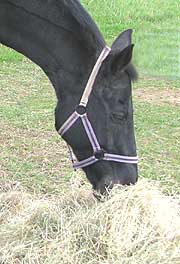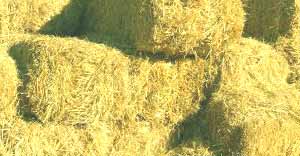Respiratory Problems in Horses - RAO, COPD and SPAOD
 If your horse
or pony has a respiratory problem such as a cough, he
wheezes or is short of breath he could be suffering from Recurrent
Airway Obstruction (RAO) or Summer Pasture-Associated
Obstructive Pulmonary Disease (SPAOD) - also known as chronic
obstructive pulmonary disease (COPD).
If your horse
or pony has a respiratory problem such as a cough, he
wheezes or is short of breath he could be suffering from Recurrent
Airway Obstruction (RAO) or Summer Pasture-Associated
Obstructive Pulmonary Disease (SPAOD) - also known as chronic
obstructive pulmonary disease (COPD).
Horses and ponies suffering from these conditions need special care
and management to allow them to live a comfortable and active life.
Difficulty in breathing causes the horse's flanks to heave - hence equine
respiratory problems have been traditionally known by many horse
owners as "Heaves". This condition is also described
as "broken wind", "hay-straw allergy"
or emphysema.
RAO and SPAOD both affect the smaller
airways of the lungs and affect the horse's capacity and ability to breathe.
These diseases cause thickening of the airway walls and the secretion
of excess mucus.
RAO is an equine disease affecting the horse or pony's
lungs. It is also referred to as chronic obstructive pulmonary
disease (COPD) although some equine veterinary surgeons now prefer
to use the description of RAO as there is also a human disease called
COPD.
RAO is mainly caused by exposure to dusts
and moulds, especially in
bedding and feed.
SPAOD (summer pasture-associated obstructive pulmonary
disease), produces similar symptoms to RAO / COPD but
has different causes. It is is associated with the pollens and dust particles
that a horse is exposed to during the summer months,
especially when it is very hot and humid.
Up until fairly recently, SPAOD was originally found
mainly in the South East of the USA, now more cases are being seen elsewhere
in the world, especially in the UK. This could be due to climate changes
as a result of global warming. SPAOD occurs in the UK in horses that are
kept out at grass during warm and humid weather conditions.
STRANGLES IN HORSES - WHAT ARE THE SYMPTOMS?
Another equine respiratory disease is Strangles. This
is highly contagious and most commonly seen in young horses. Symptoms of Strangles include
a high temperature, enlarged glands under the jaws, thick nasal discharge,
a high temperature and a cough. The swollen glands may form abscesses
which burst. Older and very young horses and ponies are more susceptible
to strangles.
If you suspect that your horse may have Strangles call
your vet immediately. The horse or pony must be isolated to try to contain
the spread of the disease. The horse may have difficulty in eating, in
which case a gruel can be fed.
A long rest period is necessary following an episode of Strangles to
ensure that no permanent damage is done to the horse's respiratory system.
It is essential to have these conditions correctly
diagnosed and treated by a veterinary surgeon.
Care of horses
& ponies with respiratory problems
- Keep horses suffering from RAO
or equine COPD turned out at grass as much
as possible - ideally this should be for 24 hours a day.
- Remove hay
from the horse's diet and get an alternate source of fibre
such as haylage.
- If your horse has to be stabled ensure that all
bedding and feed is as free of dust and mould spores
as possible.
- Don't groom or muck out your horse while he is still in
his stable as this will expose him to more dust.
- Good ventilation is always essential for the respiratory
health of your horse or pony.
- Never work your horse in a dusty arena or school.
- Feed your horse at floor level - lowering his head will
help to clear secretions from his lungs .
- Discuss a care and management regime with your vet
|
Causes
of RAO, COPD and SPAOD
- Horses suffering from RAO, COPD and SPAOD
illnesses are usually over six years old.
- RAO / COPD is common in horses that are
kept in a stable for long periods. As many
as 80% of horses who spend some part of the day stabled
have been found to have some airway inflammation.
- Respiratory problems can affect any type,
height or breed of horse or pony
- The environment in which a horse is
kept, and repeated exposure to dust and mould spores is
the primary cause of Recurrent Airway Obstruction
|
Veterinary
Treatment of Heaves
The two main equestrian treatments for respiratory
disases are drugs that dilate the bronchioles and
those that decrease the inflammation within the lungs.
One option is the drug clenbuterol (Ventipulmin)
which is given orally twice a day.
The other group are corticosteroids, which
function to reduce the inflammation occurring with respiratory
illnesses.
It is also possible to use certain human asthma drugs in
the horse using a tight fitting mask. Your veterinary surgeon
can advise you on this. |
|
 |
Signs
of Respiratory Diseases in Horses
One of the first indications that your horse
has a respiratory problem is repeated coughing
as he trys to shift the mucus in his airways.
This coughing usually occurs when he is
kept in dusty conditions or exposed to mould spores. The symptoms
can also show up when a horse is being exercised.
If the problem is not spotted early enough and the horse
or pony continues to be exposed to dust and moulds he may
then show symptoms of a runny nose. He may also lack energy
in his work and become breathless in faster work.
He may also show laboured breathing and flaring nostrils
when at rest.
Some animals deteriorate to the point where they have breathing
problems whenever they experience a dusty or mouldy environment. |
Diagnosis
Diagnosing the type of equine respiratory ailment a horse
may involve any of the following veterinary techniques:
- Ultrasound
- Radiology
- Endoscopy - A thin fiber-optic scope is inserted into
the horse's nostril and then up through the nasal passages
into the trachea and larger bronchi for examination.
- Transtracheal wash - Fluid is flushed through the trachea
via a small tube inserted into the windpipe. The fliud is
then removed for analysis of bacterial content.
- Bronchoalveolar lavage - A more representative sample
of cells is collected via a tube inserted deeply into the
lung airways.
- Pulmonary Function Testing.
|
Soaking
hay
Soaking your horse's hay
before feeding can control the dust and mould spores which
cause respiratory illnesses. A better alternative is using
a
hay steamer to steam hay
If you can only get poor quality hay it would be better to
switch to an alternative such as haylage
rather than soaking
the hay. |
|

 If your horse
or pony has a respiratory problem such as a cough, he
wheezes or is short of breath he could be suffering from Recurrent
Airway Obstruction (RAO) or Summer Pasture-Associated
Obstructive Pulmonary Disease (SPAOD) - also known as chronic
obstructive pulmonary disease (COPD).
If your horse
or pony has a respiratory problem such as a cough, he
wheezes or is short of breath he could be suffering from Recurrent
Airway Obstruction (RAO) or Summer Pasture-Associated
Obstructive Pulmonary Disease (SPAOD) - also known as chronic
obstructive pulmonary disease (COPD). 